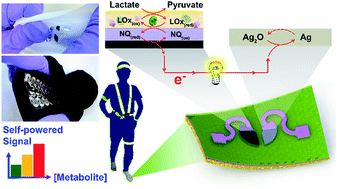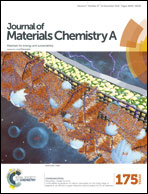Stretchable biofuel cells as wearable textile-based self-powered sensors†
Abstract
Highly stretchable textile-based biofuel cells (BFCs), acting as effective self-powered sensors, have been fabricated using screen-printing of customized stress-enduring inks. Due to the synergistic effects of nanomaterial-based engineered inks and the serpentine designs, these printable bioelectronic devices endure severe mechanical deformations, e.g., stretching, indentation, or torsional twisting. Glucose and lactate BFCs with single-enzyme and membrane-free configurations generated the maximum power densities of 160 and 250 μW cm−2 with the open circuit voltages of 0.44 and 0.46 V, respectively. The textile-BFCs were able to withstand repeated severe mechanical deformations with minimal impact on its structural integrity, as was indicated from their stable power output after 100 cycles of 100% stretching. By providing power signals proportional to the sweat fuel concentration, these stretchable devices act as highly selective and stable self-powered textile sensors. Their applicability to sock-based BFCs and self-powered biosensors and mechanically compliant operations was demonstrated on human subjects. These stretchable skin-worn “scavenge-sense-display” devices are expected to contribute to the development of skin-worn energy harvesting systems, advanced non-invasive self-powered sensors and wearable electronics on a stretchable garment.


 Please wait while we load your content...
Please wait while we load your content...